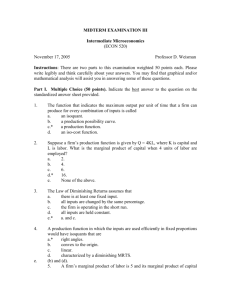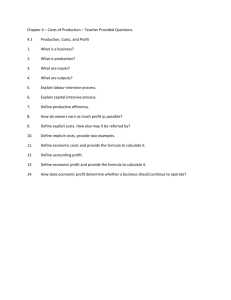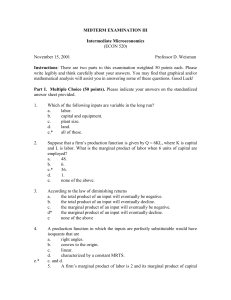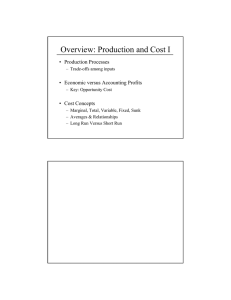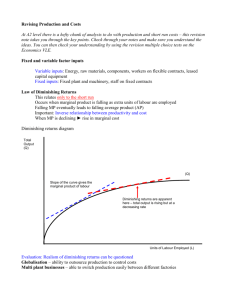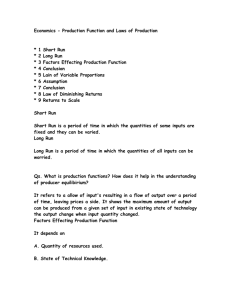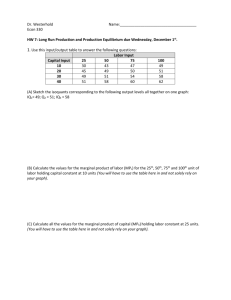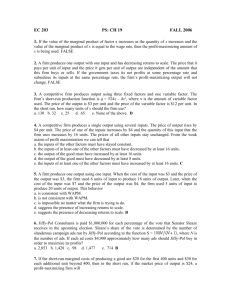MIDTERM EXAMINATION III
advertisement
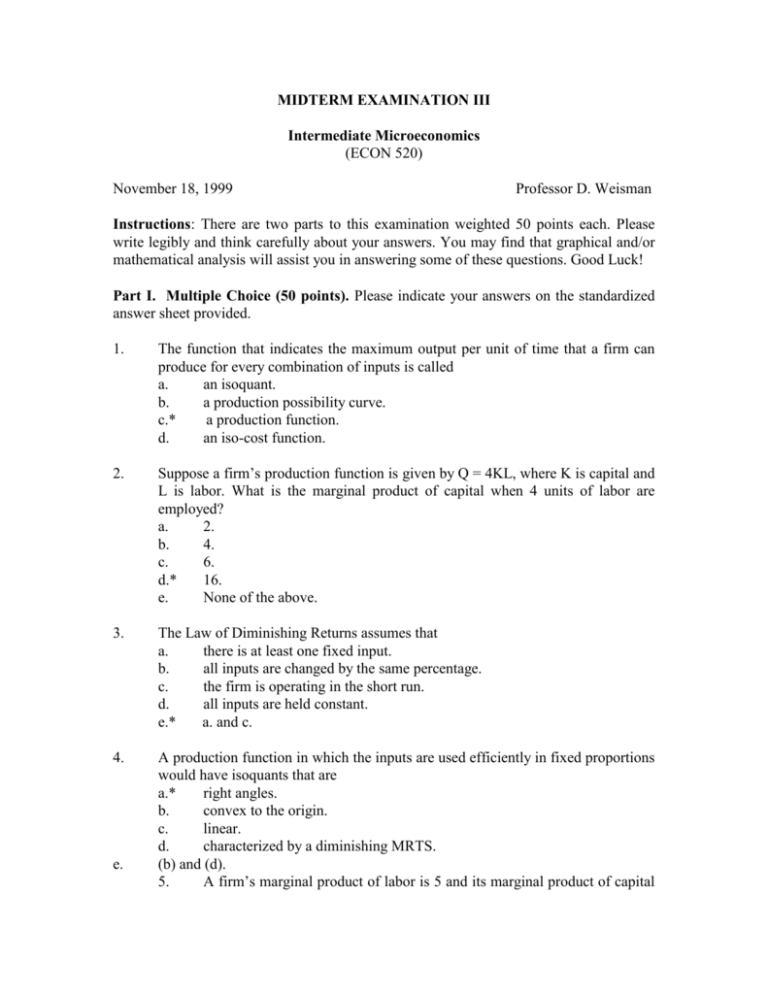
MIDTERM EXAMINATION III
Intermediate Microeconomics
(ECON 520)
November 18, 1999
Professor D. Weisman
Instructions: There are two parts to this examination weighted 50 points each. Please
write legibly and think carefully about your answers. You may find that graphical and/or
mathematical analysis will assist you in answering some of these questions. Good Luck!
Part I. Multiple Choice (50 points). Please indicate your answers on the standardized
answer sheet provided.
1.
The function that indicates the maximum output per unit of time that a firm can
produce for every combination of inputs is called
a.
an isoquant.
b.
a production possibility curve.
c.*
a production function.
d.
an iso-cost function.
2.
Suppose a firm’s production function is given by Q = 4KL, where K is capital and
L is labor. What is the marginal product of capital when 4 units of labor are
employed?
a.
2.
b.
4.
c.
6.
d.*
16.
e.
None of the above.
3.
The Law of Diminishing Returns assumes that
a.
there is at least one fixed input.
b.
all inputs are changed by the same percentage.
c.
the firm is operating in the short run.
d.
all inputs are held constant.
e.*
a. and c.
4.
A production function in which the inputs are used efficiently in fixed proportions
would have isoquants that are
a.*
right angles.
b.
convex to the origin.
c.
linear.
d.
characterized by a diminishing MRTS.
(b) and (d).
5.
A firm’s marginal product of labor is 5 and its marginal product of capital
e.
is 10. If the firm adds one unit of capital, but does not want its output quantity to
change, the firm should
a.
reduce its use of labor by 5 units.
b.*
reduce its use of labor by 2 units.
c.
maintain the same level of labor utilization.
d.
also increase capital by 1.5 units.
6.
Increasing returns to scale in production means
a.
more than twice as much of all inputs is required to double output.
b.*
less than twice as much of all inputs is required to double output.
c.
more than twice as much of only one input is required to double output.
d.
isoquants must be linear.
e.
none of the above.
7.
A firm is operating in a range of production where the Law of Diminishing
Returns has set in. The firm’s total product when 6 units of labor is employed is
20. The marginal product of the 6th unit of labor is 4. The firm’s total product
when 7 units of labor is employed is
a.
less than 20.
b.*
greater than 20 but less than 24
c.
greater than 24.
d.
24.
e.
none of the above.
8.
The marginal product of labor in the production of computer chips is 50 chips per
hour. The marginal product of capital is 100. The marginal rate of technical
substitution of hours of machine capital for hours of labor is?
a.
1.
b.*
2.
c.
1/2.
d.
50.
e.
none of the above.
9.
Which of the following statements is true regarding sunk costs?
a.
Sunk costs are avoidable costs.
b.
Sunk costs cannot be recouped once they are incurred.
c.
Sunk costs are irrelevant for making forward-looking decisions.
d.
All of the above.
e.*
b. and c.
10.
Long distance carriers AT&T and MCI are attempting to move into the market for
local telephone service in order to exploit
a.
economies of scale.
b.
diseconomies of scale.
c.*
economies of scope.
2
d.
e.
diseconomies of scope.
diminishing returns to capital.
11.
Assume that a firm’s production process is subject to decreasing returns to scale
over a broad range of outputs. Long run average costs over this range of output
will tend to
a.*
increase.
b.
decrease.
c.
remain constant.
d.
fall to a minimum and then rise.
12.
A firm that produces using a typical production function finds that at current
levels of input utilization it is producing the desired level of output and MP K =
MPL, but r > w. To minimize the cost of producing this level of output, the firm
should
a.
increase capital utilization and decrease labor utilization.
b.
maintain current levels of capital and labor utilization.
c.*
increase labor utilization and decrease capital utilization.
d.
increase both capital and labor utilization.
e.
none of the above.
13.
The firm’s total cost of producing 10 units of output is 120. At this output level,
average fixed costs are equal to 2. It follows that the firms average variable costs
are equal to
a.*
10.
b.
20.
c.
2.
d.
4.
e.
none of the above.
14.
A firm’s production function is given by Q = 4 min {K, 2L}. What set of input
combinations could represent a cost-minimizing choice?
a.
L = 2, K = 2.
b.
L = 2, K = 1.
c.
L = 2, K = 6.
d.
L = 3, K = 8.
e.*
None of the above.
15.
In the long run, which of the following is considered a variable cost?
a.
Expenditures for wages.
b.
Expenditures for research and development.
c.
Expenditures for raw materials.
d.
Expenditures for capital machinery and equipment.
e.*
All of the above.
3
16.
The government is more likely to oppose a merger between two firms if it is
known that the production process is characterized by
a.
increasing returns to scale.
b.
constant returns to scale.
c.
decreasing returns to scale.
d.*
b. or c.
e.
the Law of Diminishing Returns.
17.
A production function is given by Q = 2K + L, where K is capital and L is labor.
Suppose initially that r = 2 and w = 1. If the price of labor, w, should increase,
ceteris paribus, then it follows that
a.
the total cost of production will rise.
b.*
the total cost of production will not change
c.
more units of capital will be used in production.
d.
fewer units of labor will be used in production.
e.
a. and d.
18.
A production function is given by Q = 2K + L. The firm is minimizing costs and
produces output using 5 units of K and 10 units of L. If the price of capital, r, = 2,
then the price of labor is
a.
2
b.*
1
c.
4
d.
5
e.
unable to be determined with this information.
19.
Suppose that your grade on this examination is described by G = 2.5A0.5E0.5,
where G is your numerical score, A is ability, and E is effort measured in terms of
hours studied. This grade production function reflects
a.
increasing returns to scale.
b.
decreasing returns to scale.
c.
constant returns to scale.
d.
diminishing returns to A and E.
e.*
c. and d.
20.
The firm employs a “typical” production function that gives rise to convex
isoquants. With K plotted on the vertical axis and L plotted on the horizontal axis,
the slope of the iso-cost line is –2. Suppose the firm is minimizing the cost of
producing the desired level of output. If the MPL = 2, then the MPK =
a.*
1.
b.
2.
c.
4
d.
1/2.
e.
none of the above.
4
Part II. Problems (50 points). Answer both questions. Each question is worth 25 points.
Show all of your work to receive partial credit. Please write legibly, be precise with your
answers, and remember that economy of presentation is a desirable quality.
1. Let the firm’s production function be given by Q = 2 min {½K, L} Suppose that r = 2
and w = 8.
a) (8) How much K and L is employed in the efficient production of 20 units of output?
b) (5) What is the minimum cost of producing 20 units of output?
c) (5) Illustrate your results graphically with a representative isoquant map and iso-cost
curve.
d) (6) Determine whether this production function reflects increasing, decreasing, or
constant returns to scale? Provide the economic analysis to support your
conclusion. Construct a representative graph that illustrates the long-run average
cost curve for this production function
2.
Production and Cost Functions.
A.(12) A firm can produce each unit output using either 1/2 unit of capital (K) or 1 unit
of labor. Write down the production function that reflects these properties. Does
this production function reflect increasing, decreasing, or constant returns to
scale? Under what conditions would this firm use only capital in the production of
its output? [Assume that the firm’s objective is to minimize the cost of producing
the given level of output.]
B.(12) You have been retained as consultant for a firm that must select a long-lived
production technology. The firm has narrowed its selection to the following
choices: Q = min {K, 1/2L} and Q = ½K + ¼L. Each production technology
requires the same up-front sunk investment. Current input prices are r = 2 and w =
1. What recommendation would you make to this firm concerning its choice of
technology? Provide an economic rationale for your recommendation.
5
